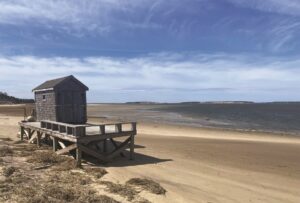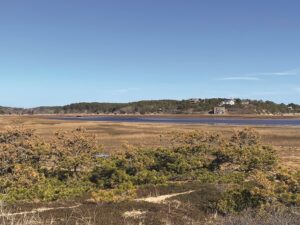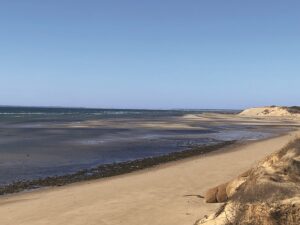I remember asking the old-timers when they thought the first spring stripers would appear. The answer was always the same: “Stripers show up when the lilacs start blooming.”
My fishing friends and I spent many an evening in Wellfleet shucking wild oysters for meat. In the 1970s, there was hardly a local restaurant offering fresh winter oysters on the menu.

Shucking would add $7.50 a pint to our regular salaries — enough to offset skyrocketing gas and heating oil prices. And while we worked, we would make guesses about water temperatures here and in the Chesapeake Bay, where most of our striper population winters over. Interpolating all those guesses, we’d arrive at when we might catch our first stripers of the season.
Today, that ritual is a mostly solitary one. Socially inspired guesswork and opinions aren’t involved anymore, because anyone can take a quick peek online to see what the 20-odd striper-oriented websites are saying about the state of the fish’s annual migration. We can chart the locations of fish by size, have instant access to water temperatures on every inch of coastline, and see graphs that show historical warming-water trends as well as precise bell curves of fish populations and striper movements over the past 20 years.
The charts are pretty clear: stripers migrate earlier than they once did. The old-timers’ predictions remain pretty accurate, though. If you look at current plant blooming charts, also available online, you see the reason. Temperatures are up everywhere.
Look up “water temperatures on Cape Cod and the Gulf of Maine.” Even a cursory scan of what’s happening around the Cape can cast a shadow over the impending joy of spring. The cold, hard truth is that the sea around us is warming faster than pretty much all the other seas of the world — 99 percent of all the global oceans, in fact. This doesn’t foretell the end of the coming striper run. But it does explain many dramatic changes to marine life on Cape Cod.

In the past 15 years alone, the water temperature in the Gulf of Maine has risen more than four degrees. That may not sound like much, but it’s likely the biggest change since the last glacial retreat 17,000 years ago. It’s the reason Cape Cod Bay was filled last summer with small bonito, a fish that until recently was considered a tropical or semi-tropical species. It’s the cause of the gradual disappearance of local lobsters, and the growing number of blue crabs. It’s why white marlin, another tropical species, is now being caught here and why black sea bass, until very recently a virtual stranger to Cape waters, is now common enough that head boats regularly take their clients out to catch them.
Contemplating the changes already well underway while trying to muster up anticipatory joy over wading out at Lieutenant Island and the Herring River to catch my first bass can give me the climate change blues.
But then I think about the extraordinary history of striped bass. In the late ’70s, stripers were so few in number here that scientists feared the stock would never come back. Their traditional spawning grounds in the Chesapeake and the Hudson River were so toxic virtually no fish were surviving the first year of life. That was the inflection point that resulted in the formation of good multi-state management and estuary cleanup programs.
Fifteen years later, the striper population was deemed fully restored.

The first ancestors of striped bass evolved in freshwater ponds and rivers 130 million years ago, well before the last three Ice Ages. When the glaciers formed, the more southerly stripers survived. As ice sheets receded and sea levels rose, many inland lakes and rivers became part of tidal ecosystems, where salmon, herring, white perch, smelt, shad, and other anadromous species thrived, able to spawn in fresh water while spending most of their adult lives foraging in the food-filled sea.
Today’s stripers begin migrating northward as water temperatures rise to the mid-40s. The first to head north are small, immature “schoolies.” Larger stripers typically winter offshore in the deeper waters of the mid-Atlantic. These larger fish enter their spawning grounds and lay their eggs in fresh water when water temperatures reach the mid-60s. After spawning, the larger fish also head northwards, resulting in two distinct phases of the spring run, with the first migration of smaller fish taking place in mid-April and the larger fish arriving a month later.
Today, the striper population is at a low but stable size. The most obvious evidence of the continued resiliency of the species is how far north they now live. Bass now overwinter in estuaries such as the Herring River and are known to be spawning in Maine’s York River and even in the Gulf of St. Lawrence.
Compared to the 100-million-year survival of the striper, our own million-year existence seems downright puny. Maybe the question is not whether the striper has the resiliency to survive. Human survival seems by far the more dubious question.



